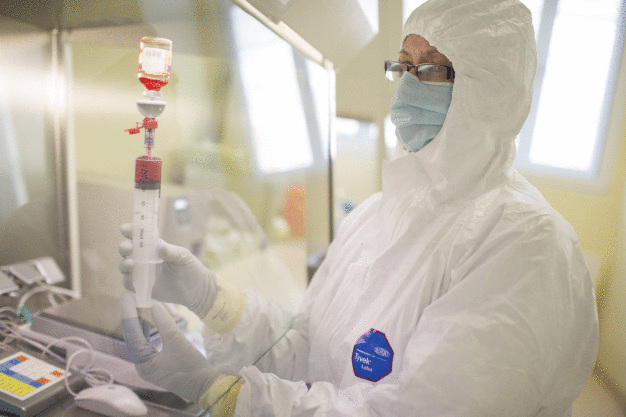Safe handling of oncology drugs made easier with Tyvek® single-use cleanroom apparel
Cytostatic drugs thanks to their healing power of destroying cancer cells can be lifesaving for patients, but may also harm healthy cells of those involved in their handling. Three protective clothing ranges - Tyvek® IsoClean®, Tyvek® and Tychem® not only provide confidence for people involved in cancer treatments, but also protect cytostatic substances from contamination, to ensure the highest quality of drugs administered to patients.
Without proper protection, cytostatic compounds represent a significant health risk as they can lead to abnormal formation of cells in healthy organisms, therefore are carcinogenic, mutagenic and reprotoxic. The greatest hazards arise by contact with cytostatic dusts, liquids or through aerosol formation. In the spirit of prevention being the best type of protection, every person handling cytostatic substances, under law must be provided with appropriate technical and organisational measures and suitable CE certified personal protective equipment (PPE). The Quality Standard for the Oncology Pharmacy Service written by the European Society of Oncological Pharmacy states: “The directives, regulations and guidelines currently in use stipulate the use of protective equipment byevery employee of a cytostatic department deriving from evaluation of the hazard involved. The PPE must carry the CE mark and must be specified in writing in the hazard evaluation.”
How to choose the right garment for handling oncology drugs?
When considering protective clothing for use with cytostatics it is crucial to know different fabric technologies as they often exhibit widely varying performance attributes. For example reusable textiles i.e. polyester garments are often subjected to multiple cycles of wearing, laundering and sterilization that can impact negatively barrier properties and durability during the garment life cycle. Reusable polyester cleanroom clothing is typically not certified as personal protective equipment according to Directive 89/686/EEC.
On the other hand, Tyvek® material due to its unique versatile structure provides an abrasion resistant barrier. It provides a high level of protection against airborne particles >1μm and against permeation of a range of low concentrated inorganic water-based chemicals. Tyvek® garments are low-linting and have a smooth surface which provides very little foothold for particle adhesion. Tyvek® material is soft, and supple making garments much more comfortable to wear than other products.
Evaluation of permeation data as a part of the risk assesment
Hazard evaluation and understanding all requirements associated with a specific application are essential to determine the most effective personal protective solution. Apart from protecting people, the products must also be protected from contamination by people, e.g. by skin particles, hair, lint or other particles originating from clothing. Product integrity and the relevant aseptic procedures and GMP guidelines bear the same weight as personal protective equipment.
PPE must be provided with appropriate technical documentation proving clothing performance properties e.g. permeation data to cytostatics. In order to provide appropriate protection against a specific chemical, the chemical permeation data needs to be consulted as knowing the toxicity or consequences of short- or long-term exposure to a hazard is essential. A permeation rate indicates the mass of the chemical in micrograms (μg), which can be transferred through one square centimetre (cm²) of the fabric in one minute (min). For further information on permeation data of Tyvek® garments please visit www.safespec.dupont.co.uk.
DuPont protective clothing - solution for every need
As single-use protective clothing, Tyvek® IsoClean®, Tyvek® and Tychem® ranges of products have the advantage that uncontaminated virgin material with a proven and documented barrier protection provided for each use.
Tyvek® IsoClean® coveralls are designed especially for use in cleanrooms and controlled environments demanding high levels of microbiological protection. Additionally, with a bacterial filtration efficiency of > 98%, Tyvek® IsoClean® coveralls offer the ability to filter out bacteria.
Protective suits made of Tyvek® are also suitable for activities involved in the production of cytostatics and offer different levels of protection depending on hazard type. Moreover, CE certified Tyvek® coveralls are available as Cat. III PPE. Accessories made of Tychem® C provide additional protection from inorganic chemicals for body parts subjected to high levels of exposure.









